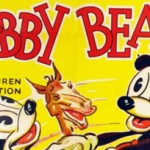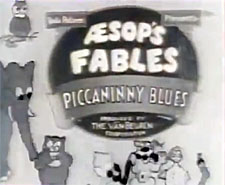


More from the prolific year of 1933, with RKO still riding high, and its cartoon output continuing to improve in its technical abilities and budgets. Also, a brief look back at a forgotten scarcity from the preceding year, which deserves rediscovery.
 As noted last time, with apologies for overlooking it previously, I discuss the rare Piccaninny Blues (12/12/32) – A southern cat is busy plowing his cotton field – but only by being towed lazily down the river by his mule in a flatboat. He dreams of the far-off land of Egypt, and of the days of Cleopatra. Suddenly, his mule jumps in the boat with him, propelling him upwards and halfway around the world to Egypt. He winds up joining a caravan, then is inhaled by a Sphinx with a head cold. He tumbles down stairs into the Sphinx (a nice 3-D perspective, taking inspiration both from “Bimbo’s Initiation” and Disney’s “Egyptian Melodies”), where he encounters mummies, mummy cases, and dancing girls (some of whom are drawn quite well). Eventually, he finds a feline Cleopatra, who is amazingly well preserved in her case, and escapes with her in a stylish dog-drawn chariot – but ultimately, it all turns out to be a dream (standard cop-out #1), as he is licked back into wakefulness by his mule. Songs: “Vision of Salome”, “Dardanella” “The Doll Dance” “Old Folks at Home” “The Shiek of Araby”, and a newcomer, “Egypt (My Cleopatra)”, a 1904 song written by Clare Beecher Kummer, recorded by Harry Tally on Columbia.
As noted last time, with apologies for overlooking it previously, I discuss the rare Piccaninny Blues (12/12/32) – A southern cat is busy plowing his cotton field – but only by being towed lazily down the river by his mule in a flatboat. He dreams of the far-off land of Egypt, and of the days of Cleopatra. Suddenly, his mule jumps in the boat with him, propelling him upwards and halfway around the world to Egypt. He winds up joining a caravan, then is inhaled by a Sphinx with a head cold. He tumbles down stairs into the Sphinx (a nice 3-D perspective, taking inspiration both from “Bimbo’s Initiation” and Disney’s “Egyptian Melodies”), where he encounters mummies, mummy cases, and dancing girls (some of whom are drawn quite well). Eventually, he finds a feline Cleopatra, who is amazingly well preserved in her case, and escapes with her in a stylish dog-drawn chariot – but ultimately, it all turns out to be a dream (standard cop-out #1), as he is licked back into wakefulness by his mule. Songs: “Vision of Salome”, “Dardanella” “The Doll Dance” “Old Folks at Home” “The Shiek of Araby”, and a newcomer, “Egypt (My Cleopatra)”, a 1904 song written by Clare Beecher Kummer, recorded by Harry Tally on Columbia.
Barking Dogs (3/15/33) – Cubby Bear’s girlfriend is about to lose her happy home for non-payment of mortgage. An apparently villainous wolf landlord comes by in his car that looks nothing short of a Frankfurter on four wheels. Two white dogs belonging to Cubby’s girlfriend prove to be quite vociferous, and wind up attacking the lupine landlord. The dogs commandeer the landlord’s car, and Cubby and the girl make off with it. While they don’t come out and say it, it looks like the bears may become a family, as Cubby tells the dogs “Home, James” in one of his few lines of dialogue. Songs: “Home Sweet Home”, and “Willow, Weep For Me”, a 1932 torch song. Paul Whiteman recorded it twice – once as a conventional single, and again as part of a medley for a 33 1/3 RPM “Program Transcription”, both for Victor, and both with vocal by Irene Taylor, a Texas singer who later married Segar Ellis. Other recordings included Ted Fio Rito on Brunswick. In later years, there were versions in the LP era by Frank Sinatra on Capitol (“Only the Lonely”), Billie Holiday on Clef, and Ella Fitzgerald on Verve. It was a hit in 1964 for Chad and Jeremy on World Artists (embed below).
The Bully’s End (6/16/33) – A local rooster is the real bully of the barnyard. He purs up a placard that he will fight any contender. A fight ensues, but surprisingly, the rooster is thoroughly trounced. Songs: “There’s Gonna Be a Fight”, presumably an original song by Rodemich.
Doughnuts (7/10/33) – A parade of pastries, which would have benefitted greatly from Technicolor if available. Tom and Jerry are doughnut vendors, but losing all attention to a beer and 3.2 percent pretzels booth. This cartoon is an equal opportunity offender, taking aim at Jewish shopkeepers, stereotype “pansy” homosexuals, and inebriated sailors. Said sailor drops a jug of booze into T&J’s doughnut batter, then shifts their treadmill doughnut maker into high, making Tom and Jerry’s product the hit of the convention. Songs: “Down Where the Wurzburger Flows” (reference to a brand of beer), a 1902 song which set the pattern for later songs (such as “Under the Anheuser Bush”). Arthur Collins would record it alone for Victor and for Columbia cylinder, also on Leeds with gold foil label, and together with Byron G. Harlan on Edison cylinder. Edison also issued a xylophone version by Albert Benzler. It was revived for “Old Time Waltz Medley” by Jimmy Carroll and his Orchestra in 1936 on Vocalion. “The Mug Song” also appears, the most common version of which is by the High Hatters on Victor., and also by Johnny Walker and his Rollickers on Columbia. Snips of “Mazel Tov”, “For He’s a Jolly Good Fellow”, and “Go In and Out the Window” also make appearances, plus an original fragmental song sung by the judges, and a possible short original at the close of the cartoon. “Drink, Drink, Drink” (not to be confused with the famous song from The Student Prince).
Rough on Rats (7/14/33) – The final Aesop’s Fable, until the banner was taken up once again by sporadic entries un the Terrytoons library years later, Three kittens, one white, one gray, one black, are cavorting about an old grocery store. In the course of their mischief, the black kitten gets captured by a large rat, and is to be sliced into deli meat by the use of a large buzz-saw-like meat slicer. The tide of battle turns, and the rat winds up getting the works from the kittens, ending with the rat stomped out of existence by a well-tossed boot. The kittens are reunited, and happy as the proverbial clam. Songs: “Little Kittens”, an original song not to be confused with the nursery rhyme.
The Phantom Rocket (7/31/33) – Tom and Jerry are flying an experimental rocket ship, to a great deal of fanfare from the press. Although this rocket turns out to be much more airworthy than their failed launch in the earlier “The Rocketeers”, the takeoff is marred by a pair of crooks who commandeer the craft for a getaway. A series of airborne misadventures ensue, and somehow T&J manage to foil the crooks and make the capture. Songs: two originals: “A Most Amazing Sight”, a long number that opens the cartoon, introducing every character who worked on the project, and “Cheers For Tom and Jerry”, used near the end of the film, as they emerge with the situation well in hand.
World Flight (8/25/33) – Cubby Bear is going to fly around the world. Instead, he winds up going through the world, passing through the Plutonian abode, where the main inhabitant complains about the uninvited guest passing through – then all the way to China. He manages to fly over much of Asia and Eirope, before getting caught in a storm over the Atlantic. Lightning, does a number on his plane, sawing off wings, etc. He winds up hanging by his suspenders off one of the spikes of Lady Liberty’s crown in New York harbor, where he receives the accolades of the public – and even King Kong. Songs: a couple of originals: “We’ll Fly High”, heard at the beginning of the cartoon and also in mock-Chinese when Cubby reaches his halfway point, and a song in praise of Cubby’s accomplishments, which I’ll call “Hooray for Cubby Bear”, appears in the finale sequence.
The Fatal Note (9/19/33) – The premiere episode of The Little King series. The whole kingdom is praising the King, who is about to take his daily piano lesson. A revolutionary with a hook nose and a tendency to wear robes instead of a suit plots to overthrow the King with a cannon and black bomb. He wires the bomb to one of the high notes of the piano, in a precursor of a gag which would become a Warner Brothers staple. The King does not get blown up, and chases the revolutionary throughout the palace. The villain gets tangled up in a bell tower, heralding the safety of the King to the kingdom. Song: an original by the populace in praise of the King, segueing into singing about his piano practice.
Still continuing 1933, next time.